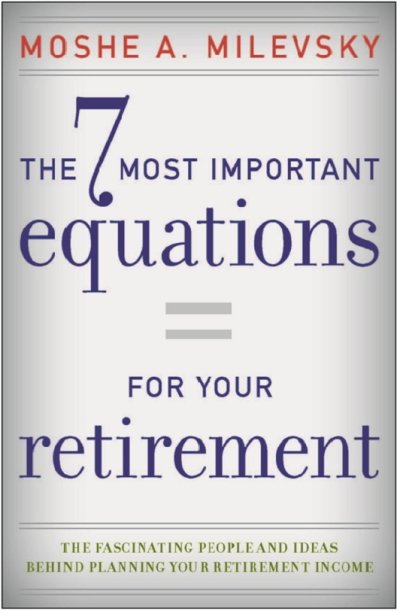Midpack
Give me a museum and I'll fill it. (Picasso) Give me a forum ...
Just stumbled across this book, by Moshe A Milevsky, and requested it from our local library. Did a search here, but didn't get any result. Anyone read it?
Table of Contents
Introduction: An Equation Can't Predict Your Future . . .But It Can Help You Plan for It 1
Chapter 1: How Long Will My Number Last?
Equation #1: Leonardo Fibonacci (1170–1250) 7
Chapter 2: How Long Will I Spend in Retirement?
Equation #2: Benjamin Gompertz (1779–1865) 31
Chapter 3: Is a Pension Annuity Worth It?
Equation #3: Edmond Halley (1656–1742) 53
Chapter 4: What Is a Proper Spending Rate?
Equation #4: Irving Fisher (1867–1947) 77
Chapter 5: How Much in Risky Stocks versus Safe Cash?
Equation #5: Paul Samuelson (1915–2009) 101
Chapter 6: What Is Your Financial Legacy Today?
Equation #6: Solomon S. Huebner (1882–1964) 125
Chapter 7: Is My Current Plan Sustainable?
Equation #7: Andrei N. Kolmogorov (1903–1987) 151
Conclusion: Controversies, Omissions and Concluding Thoughts 175
Appendix: Crash Course on Natural and Unnatural Logarithms 179
Table of Contents
Introduction: An Equation Can't Predict Your Future . . .But It Can Help You Plan for It 1
Chapter 1: How Long Will My Number Last?
Equation #1: Leonardo Fibonacci (1170–1250) 7
Chapter 2: How Long Will I Spend in Retirement?
Equation #2: Benjamin Gompertz (1779–1865) 31
Chapter 3: Is a Pension Annuity Worth It?
Equation #3: Edmond Halley (1656–1742) 53
Chapter 4: What Is a Proper Spending Rate?
Equation #4: Irving Fisher (1867–1947) 77
Chapter 5: How Much in Risky Stocks versus Safe Cash?
Equation #5: Paul Samuelson (1915–2009) 101
Chapter 6: What Is Your Financial Legacy Today?
Equation #6: Solomon S. Huebner (1882–1964) 125
Chapter 7: Is My Current Plan Sustainable?
Equation #7: Andrei N. Kolmogorov (1903–1987) 151
Conclusion: Controversies, Omissions and Concluding Thoughts 175
Appendix: Crash Course on Natural and Unnatural Logarithms 179


